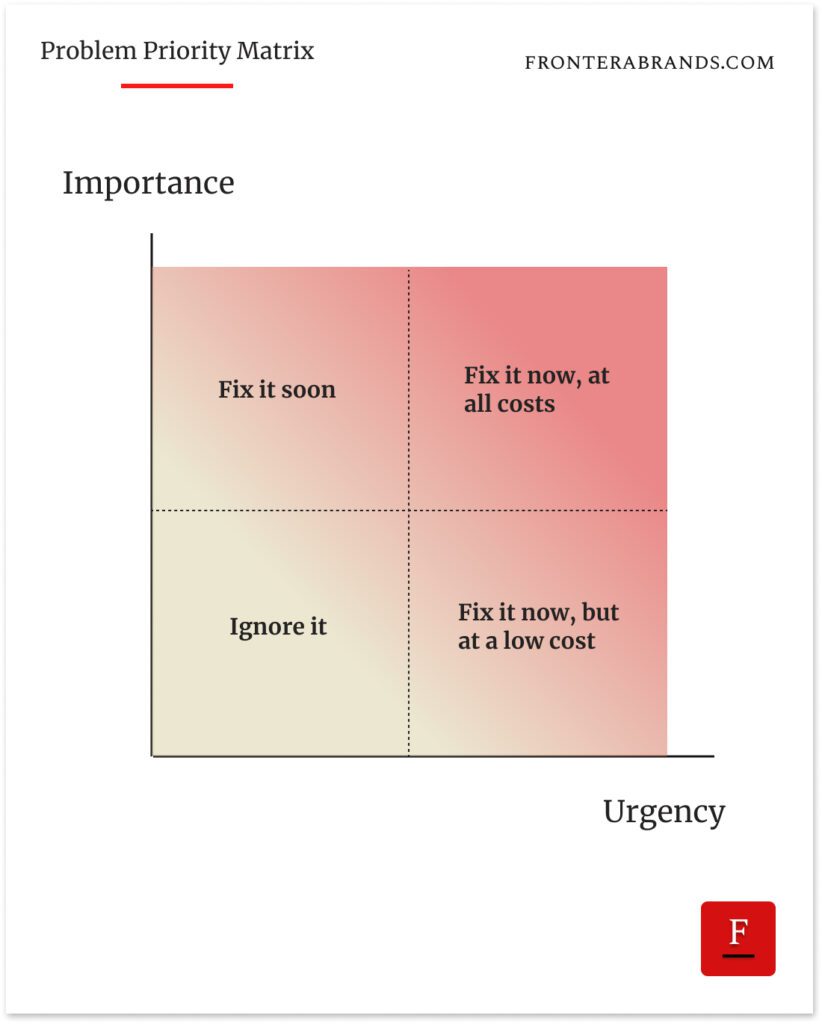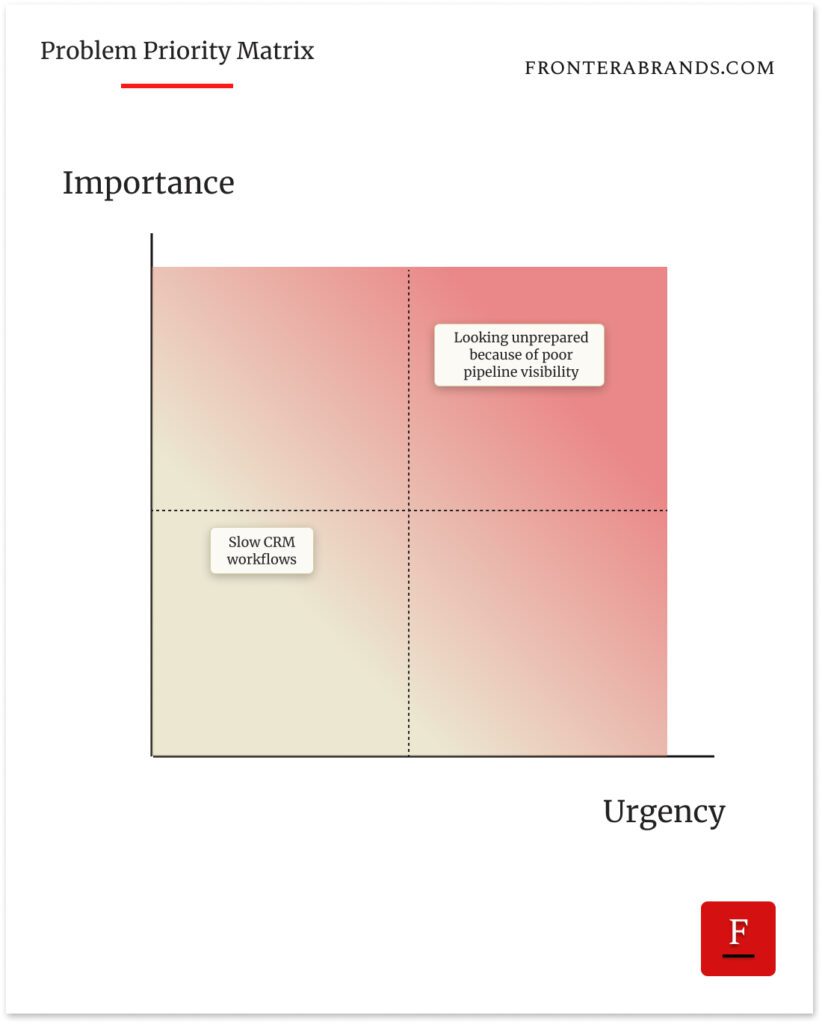♦️ How B2B buyers choose which problem to fix (and how to make yours the priority)
|
Every business has dozens of problems at any given time. Even thriving ones. A new regulation comes up and you have to comply. You have to hire but can’t find the right candidate. Or your clients churn and you have to find out why. Being in business means dealing with problems. It’s the same for your potential clients. The problem your firm claims to solve is among a huge list of problems your buyers have. They have limited time and resources. But many problems to solve. So how do they decide which ones are worth fixing?
It’s a simple matrix for productivity geeks to prioritize what tasks they have to do. Depending on the importance and urgency of the task: you do, delegate, decide when to do, or eliminate it. The funny thing is your buyers intuitively think this way. When a problem is too pressing and important, they decide to fix it now. But if a problem is neither important nor urgent, they ignore it. So it looks like this:
To sell your services more easily, you have to solve an important problem. Otherwise, your problem ends up at the bottom of the buyers’ list. It never gets resources. But this is where things get interesting. Because whatever service you offer, you actually solve multiple client problems. For example. Our brand strategy engagements help our clients solve different problems:
So even a single service can be tied to multiple client problems. It’s the same for your offers. And depending on which one you choose to message on, you can increase its priority in the eyes of the buyer. Then the question is: How can you know which one is more important to buyers? And how can you increase that problem’s urgency? So among their huge list of problems, they decide to spend their resources on your problem. Here are two ways: 1. Focus on emotional necessityLet’s unpack the word “importance.” What makes a problem important in the B2B context? Sure, every B2B offer boils down to making or saving money. But if you look a few layers deeper, the importance comes down to buyers’ emotional necessity. Which problem you solve threatens your buyer’s credibility, reputation, or future the most? Which problem causes the most annoyance? Let’s say you have an IT firm that does CRM improvements. You can message about the “your CRM workflows are clunky and slow” problem. Or you can message about “you look unprepared to your leadership team because of broken pipeline visibility.” The same service. Two different problems. Which one has more emotional necessity to fix? Which one would go higher on the buyers’ problem list? A VP of sales can live with a slow CRM workflow. Sure, he’d hear some complaints from his team every now and then. But it wouldn’t get him fired. So he might acknowledge that the problem exists, yet decide not to spend resources to fix it. But he cannot afford to look incompetent in front of leadership with inaccurate information about their sales pipeline. There is a higher emotional necessity to fix that problem. And that means that the buyer would be more likely to spend resources when the same service is framed that way.
Well, your firm solves a wide range of problems for your clients. List all of them. Which one triggers more emotional necessity for your buyers to fix? If you want to sell more easily, choose a problem where the stakes are visible, personal, and high. And build your messaging around it. Remember. You’re not only competing with competitors who solve the same problem as you. You also compete with your buyers’ other problems. And they prioritize the problems they can’t afford to ignore emotionally. 2. Keep the problem top of mindWe’ve defined importance. Now let’s focus on urgency. Some business problems are inherently urgent — like tax declarations. They come with deadlines that you can’t skip. But many other problems are not like that. Even when they are important, buyers might not feel the urgency to fix them today. So how can you make your problem more urgent on the buyers’ list? An easy way is by using selective perception. Let me explain. When you base your messaging around an important buyer problem and repeat it again and again, the problem stays top of mind. So potential clients who regularly follow your content or see your ads start noticing the symptoms in their daily lives. Hence your problem starts to feel more urgent than the rest. If you can get a CEO to think about “low employee retention” again and again, that person will start paying attention. A team leader who seems distracted in meetings. A top performer updating her LinkedIn profile. That reliable director taking random Tuesday afternoons off. Suddenly, retention will go from HR’s problem to the CEO’s top three priorities. The turnover problem was always there and important. But selective perception makes it urgent. So use your mental availability channels and repetition to keep your problem top of mind. Your buyers will notice the symptoms and feel the urgency to act. After all, that’s what good marketing does. It changes priorities. Why does every consulting firm website sound like they were all written by the same person in 2003?You’re great at what you do. Your clients love you. But new prospects? They don't get it. They don't see what makes you different from your website, ads, or content. So they go with the big, familiar firms as the "safe" choice. You know why? Because your value is only as good as your messaging. If your website, ads, or content don't clearly show how you're different, prospects won’t see it. You become just another provider. And that costs you sales without you knowing — every single day. We help boutique consultancy firms define what makes them different and express it with clear messaging. So your ideal clients notice you, recognize your value, and think: “This is exactly what we need.” Want to stop losing sales to weak messaging? Fill out this form to book a free clarity call. And you can connect with me here on LinkedIn. Ozan |
Frontera
Join 10,000+ B2B founders getting the strategies of iconic brands.
The biggest mistake in B2B messaging is copying consumer brands. I know. Who doesn’t want to be inspirational like Nike? Who doesn’t want to influence buyers with a strong mission like Patagonia’s? But think about it. These are consumer brands. They sell commoditized products. A jacket is a jacket. No matter what brand you buy from, the product functionally does the same thing. So to differentiate themselves, consumer brands have to give intangible meaning to their tangible products. They...
In 1970, Listerine’s marketing department was feeling the heat. P&G had launched a new mouthwash brand as a competitor a few years before. They called it Scope. And they attacked Listerine’s obvious weakness — taste. Listerine burned like medicine. Consumers knew it. So Scope entered the market using taste as its differentiator. They claimed a mouthwash didn’t have to taste bad. And they were quickly gaining market share with aggressive ad campaigns. “Scope fights bad breath without giving...
Most marketers think social proof sells. But it doesn’t. It reassures. And this difference changes how to do messaging right. Imagine going to a B2B brand’s website. You’d like to figure out what they do. But you struggle. Because first, you read an aspirational mission statement that means nothing. Then they bombard you with social proof: “We helped this many clients.” “We generated this much revenue.” You keep scrolling to find an explanation of what the hell this brand does. But no chance....





